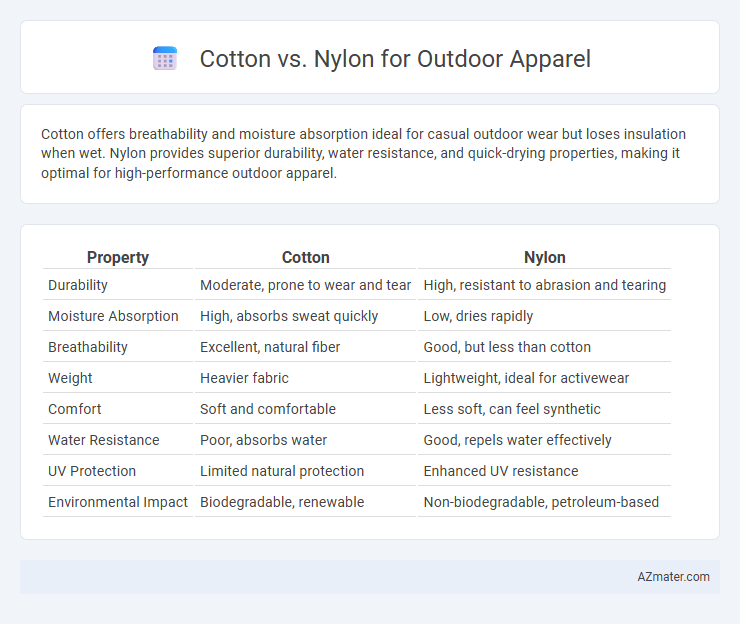Cotton offers breathability and moisture absorption ideal for casual outdoor wear but loses insulation when wet. Nylon provides superior durability, water resistance, and quick-drying properties, making it optimal for high-performance outdoor apparel.
Table of Comparison
| Property | Cotton | Nylon |
|---|---|---|
| Durability | Moderate, prone to wear and tear | High, resistant to abrasion and tearing |
| Moisture Absorption | High, absorbs sweat quickly | Low, dries rapidly |
| Breathability | Excellent, natural fiber | Good, but less than cotton |
| Weight | Heavier fabric | Lightweight, ideal for activewear |
| Comfort | Soft and comfortable | Less soft, can feel synthetic |
| Water Resistance | Poor, absorbs water | Good, repels water effectively |
| UV Protection | Limited natural protection | Enhanced UV resistance |
| Environmental Impact | Biodegradable, renewable | Non-biodegradable, petroleum-based |
Introduction to Cotton and Nylon for Outdoor Apparel
Cotton offers natural breathability and moisture absorption, making it comfortable for mild outdoor activities but tends to retain water and dry slowly. Nylon is a synthetic fiber known for its durability, quick-drying properties, and resistance to abrasion, making it ideal for demanding outdoor conditions. Understanding the performance characteristics of cotton and nylon is essential for selecting appropriate outdoor apparel tailored to specific environmental challenges.
Key Characteristics of Cotton
Cotton is a natural fiber known for its breathability, softness, and excellent moisture absorption, making it comfortable for outdoor apparel in mild conditions. Its ability to absorb sweat helps keep the body cool but also means it retains moisture, which can lead to longer drying times and potential chafing during intense activities. Despite its comfort, cotton lacks the quick-drying and durability features of synthetic fabrics like nylon, making it less ideal for high-performance or wet environments.
Key Characteristics of Nylon
Nylon is a synthetic fiber renowned for its high tensile strength, durability, and exceptional abrasion resistance, making it ideal for rugged outdoor apparel. Its moisture-wicking properties and quick-drying ability enhance comfort during intense physical activity or wet conditions. Additionally, nylon's lightweight and elasticity contribute to enhanced flexibility and long-lasting performance in diverse outdoor environments.
Comfort and Breathability Comparison
Cotton offers superior breathability and natural moisture absorption, making it highly comfortable for low-intensity outdoor activities in dry conditions. Nylon excels in moisture-wicking and quick-drying properties, providing better comfort during high-intensity or wet weather activities by preventing the fabric from clinging to the skin. The choice between cotton and nylon depends on activity level and environmental conditions, with nylon favored for durability and performance in varied climates while cotton suits casual, dry environment use.
Durability and Longevity in Outdoor Conditions
Nylon outperforms cotton in durability and longevity for outdoor apparel due to its high tensile strength and resistance to abrasion, making it ideal for rugged environments. Unlike cotton, nylon fabric maintains integrity when exposed to moisture, drying quickly and resisting mildew, which extends garment lifespan during prolonged outdoor use. The synthetic fibers of nylon also exhibit superior elasticity and UV resistance, ensuring sustained performance and durability under harsh weather conditions compared to natural cotton.
Weather Resistance: Water and Wind Protection
Nylon outperforms cotton in outdoor apparel due to its superior water resistance and wind-blocking capabilities, essential for harsh weather conditions. While cotton absorbs moisture and loses insulation when wet, nylon's synthetic fibers repel water and dry quickly, maintaining warmth and comfort. Nylon's tightly woven structure also provides effective wind protection, making it the preferred choice for durable, weather-resistant outdoor clothing.
Weight and Packability for Outdoor Activities
Nylon outperforms cotton in weight and packability, with lightweight fibers that compress easily for compact storage in backpacks during outdoor activities. Cotton's heavier and bulkier nature leads to increased pack weight and reduced space efficiency, making it less suitable for extended hikes or ultralight packing strategies. Ultralight nylon garments provide moisture resistance and durability, enhancing performance in variable weather conditions while optimizing load management.
Maintenance and Care Requirements
Cotton outdoor apparel requires gentle washing with mild detergents and air drying to prevent shrinkage and fabric wear, while nylon is more resistant to abrasions and can often be machine washed and dried with less risk of damage. Nylon's quick-drying properties reduce the likelihood of mold and mildew buildup, making it easier to maintain during extended outdoor activities. Both materials benefit from avoiding high heat and harsh chemicals to preserve fabric integrity and performance.
Environmental Impact of Cotton vs Nylon
Cotton cultivation requires significant water resources and often relies on pesticides, contributing to soil degradation and water pollution. Nylon production involves petrochemicals with high energy consumption and emits nitrous oxide, a potent greenhouse gas. Biodegradability favors cotton, which decomposes naturally, whereas nylon persists in the environment, adding to microplastic pollution.
Best Use Cases for Cotton and Nylon Outdoor Apparel
Cotton outdoor apparel excels in breathability and softness, making it ideal for low-intensity activities in dry, warm environments where comfort and moisture absorption are priorities. Nylon outdoor gear is highly durable, water-resistant, and quick-drying, suited for high-intensity activities like hiking or climbing in wet or rugged conditions. Selecting between cotton and nylon depends on activity level and weather, with cotton favored for casual wear and nylon for performance-driven outdoor pursuits.

Infographic: Cotton vs Nylon for Outdoor Apparel
 azmater.com
azmater.com